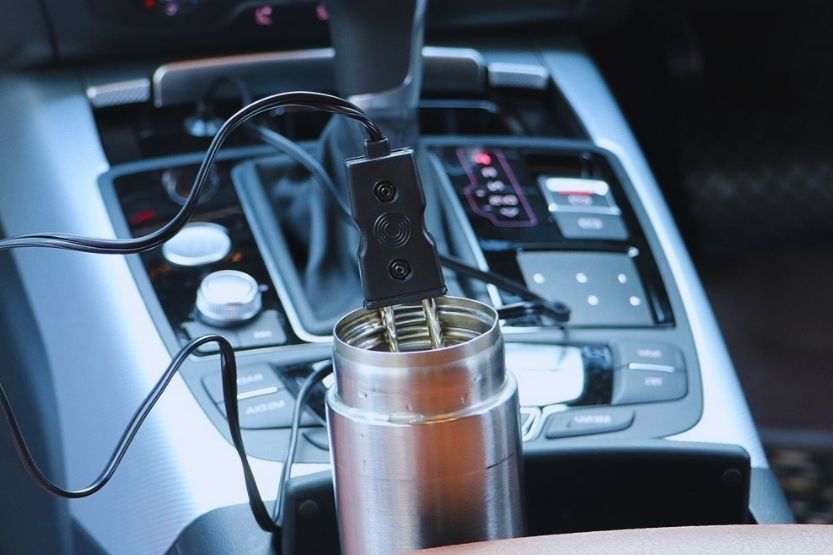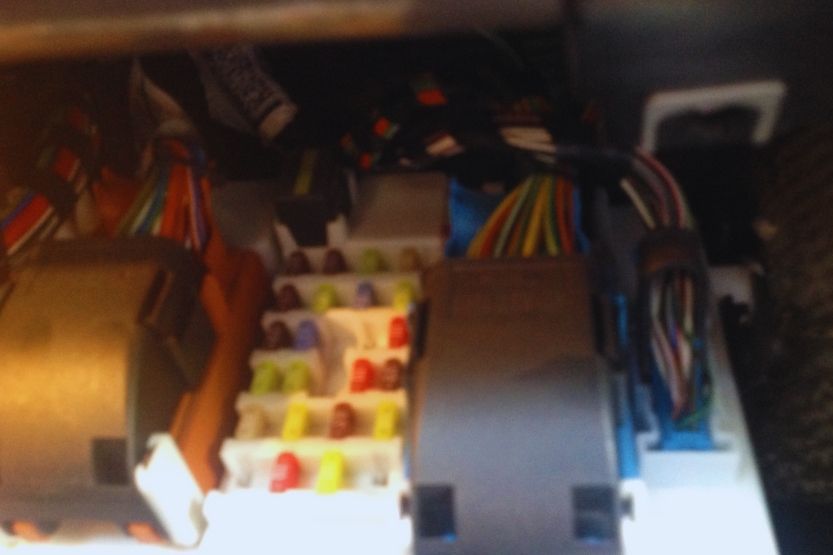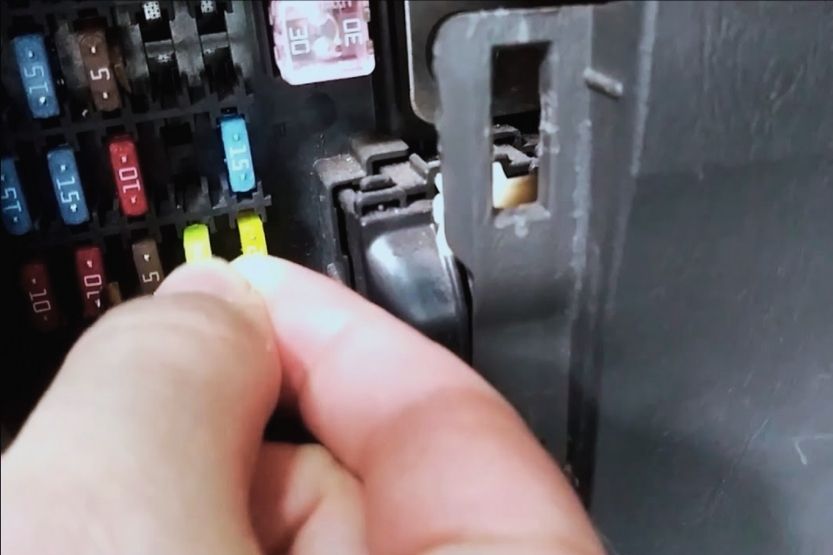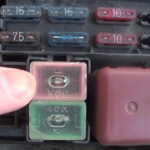It isn’t very pleasant to have a blown car fuse. But don’t get irked with the fuse. It’s just doing its job. Is there a reason why the cigarette lighter fuse keeps blowing? What are the causes, and how do you replace them?
Like all electrical fuses used in cars, the cigarette lighter fuse will also blow when the connected circuit draws more amperage than it is supposed to handle. For instance, if the fuse is designed to take only 15 amps, and the current drawn gets more than 15 amps, it will blow.
When the fuse blows out, you have to replace it with one with the same amperage rating and preferably the same cigarette lighter fuse name. All you need to do is to get a pair of needle-nose pliers. Use these pliers to pull out the fuse. The thin wire inside the fuse will be disconnected if it’s blown.
Read on to learn more about the most common reasons the cigarette lighter fuse constantly blows out and how you can replace it.
Cigarette Lighter Fuse Keeps Blowing?

Draws More Amperage Than the Fuse Can Handle
Like all other electrical fuses for cars, the cigarette lighter fuse will blow if its circuit draws more amperes than it should handle. For instance, if the fuse is rated at 15 amps, it will blow when the circuit draws more than that amperage.
Fuse Replacement
If the fuse has already blown, there’s nothing you can do but change it. You need to use a pair of needle-nose pliers to do that. Just pull out the blown fuse and examine it.
Disconnected Wire
If the thin wire inside is already disconnected, the fuse is blown. Get a new fuse with the same ampere rating and push it onto its latch.
Accumulation of Dirt and Debris Inside the Cigarette Lighter
There are several reasons why this fuse will blow. One of the most common reasons is the accumulation of dirt and debris inside the cigarette lighter itself, which causes shorts leading to the fuse blowing out.
Charge Cell Phone and GPS Devices
The cigarette lighter fuse symbol on your car is not only useful for lighting cigarettes. You can also use it to charge your cell phone and GPS devices. If its fuse is continuously blowing and you need to use it, you can bypass the fuse to use the socket of the cigarette lighter.
What Is a Fuse’s Basic Function
An Electrical Device That Safeguards Electric Circuits
A fuse is an electrical device that safeguards electric circuits. If there’s a surge of power that a circuit can’t handle, the fuse will be the first to blow, effectively cutting off the power so that it can’t ruin the whole circuit.
That’s the same function of the cigarette lighter socket’s fuse. So, your problem is that its fuse is constantly blowing out repeatedly. There’s something that is causing it to act this way.
Problem with Cigarette Lighter’s Wirings
The problem is not really with the fuse. It could be with the wirings of the cigarette lighter, the gadget that you are plugging in the socket, or maybe even the cigarette lighter itself. You have to isolate the underlying cause to solve this problem once and for all.
Do Not Replace the Blown Fuse with a Fuse of a Higher Amperage Rating
You need to know how to check the cigarette lighter fuse and every possible cause of this issue. Whatever you find out, you are not advised to replace the blown fuse with a fuse of a higher ampere rating.
You risk damaging the fuse box, melting the wires, or even causing a fire if you do this.
Consists of a Socket Connected to the Power Source and the Ground
You should also understand how the cigarette lighter in your car works. It consists of a socket connected to the power source and the ground. The lighter is encased in a removable metal or plastic housing with a coiled metal strip.
The inside wall of this socket is grounded. There’s a pin at the center connected to a power source. In between the power source and the pin is the fuse. The current will pass through the coiled metal strip if you push the lighter into the socket. This causes it to heat up.
Can Draw Around 10 Amp During Normal Operation
During normal operation, this lighter can draw around 10 amperes. The electrical circuit normally uses a 10 to 15 amperes rating fuse. So, you can plug in a phone charger and other plug-in devices to this socket. But they must be rated to draw only from 10 to 15 amps.
Designed to Supply Power to Adapters and 12-volt Electrical Gadgets
The cigarette lighter socket is designed to supply power to adapters and 12-volt electrical gadgets. If you use a 12-volt accessory socket on a circuit that keeps on blowing fuses, you can use the same diagnostic procedure to see what’s causing the problem.
What to Do If You Keep Blowing a Fuse?
Replace the Cigarette Lighter Fuse
If the fuse of your car’s cigarette lighter blows, you have to replace it so you can use the socket as always. However, if you’ve replaced the blown fuse and the new one blows out again, there must be another problem.
Not Safe to Replace the Fuse with One of a Higher Amps Rating
You may think that the easiest solution is to replace the fuse with one of a higher amps rating. That’s dangerous if you consider the fuse’s basic function.
If the electrical wiring of the cigarette lighter can’t handle more than 15 amps, you are risking a short circuit or even an electrical fire if the wirings can’t handle the power surge.
Not a Good Idea to Replace the Fuse with a Circuit Breaker
Replacing the fuse with a circuit breaker is also not a good idea. It will overload the cigarette lighter, which the wires can’t also handle.
Identify the Problem
So, you need first to understand where the problem is coming from. If the fuse of the cigarette lighter is constantly blowing out, there are four top common causes. They are:
- Short in the electrical wiring
- The ampere rating of the fuse is small
- There’s a circuit overload
- Bad component
We will now discuss the details of these common causes.
What Would Cause a Fuse to Keep Blowing in a Car?

1. Short in the Electrical Wiring
Current or Electricity Goes Straight to the Ground
If the cigarette lighter fuse size or amp rating is correct, but it keeps on blowing, it could mean there’s a short in the circuit or electrical wiring. A short means the current or electricity goes straight to the ground instead of where it is supposed to go.
Electricity Will Not Be Generated
Electrons like to travel short distances. They take shortcuts. So, if a shortcut to the ground is introduced in the circuit, the electrons or the electricity is quickly diverted away from the cigarette lighter socket. It won’t generate electricity; in this case, it will not generate heat.
Production of Excessive Heat
Additionally, since there is no resistance provided by the thin electrical wires inside the cigarette lighter, the energy or electricity will flow unrestricted to the ground. This will produce excessive heat, which will cause the fuse to blow.
There are two common reasons why a short circuit develops in an electrical wiring system: moisture contamination and chafing.
2. Moisture Contamination
Causes Rust
Moisture is an enemy of automotive vehicles. It causes rust, but we’re not talking about that problem now. Moisture destroys electrical circuits. And your modern car has plenty of electrical wirings that moisture can destroy.
Leaking Issues
If your car has leaking problems that go unnoticed and unrepaired, you will experience electrical problems. When water or moisture contaminates an electrical circuit or an electrical device, the circuit or the device will start acting strange.
Allow the Current to Take a Shortcut
Moisture in an electrical circuit will allow the current to take a shortcut. Electricity or energy will flow from the positive to the negative side or the ground. That causes the short, which results in the fuse blowing out.
3. Chafing
Happens When a Wire Carrying the Power Supply Rubs on the Car’s Metal Part
Chafing happens when the wire carrying the power supply rubs on a metal part of the car. This continuous rubbing can damage the plastic insulation of the wire. The electrical wires will be exposed.
Increase Damage to the Wire’s Insulation
As the chafing continues, the damage to the wire’s insulation will get bigger. More electrical wires will be exposed. Pretty soon, these exposed electrical wired will come in contact with the metal part of the car. This situation will cause a short in the circuit, and the fuse blows.
Common in Older Cars
Chafing of the electrical wiring usually happens in older cars. Cars with high mileages are more prone to vibration. As the metal body parts of the vehicle vibrate more aggressively, they contact the electrical wires.
Worn-out Wiring Looms
These things usually happen when wiring looms do not properly secure the electrical wires, the looms are already wearing out due to old age, or the looms were not properly replaced or secured after an electrical wiring repair on the car.
This issue gets more severe if the electrical wiring looms are situated near car parts that produce excessive heat like the engine, the alternator, the compressor, and the lights.
Again, why does the cigarette lighter fuse keep blowing? Cigarette lighter fuses usually blow when they cannot handle the amperage drawn by the circuit. For example, it will blow when you have a 12-amp cigarette lighter fuse, but the circuit draws more.
4. Too Small Fuse Amp Rating
A Fuse’s Main Function Is to Cut Off the Flow of Electricity
The main function of a fuse is to cut off the flow of electricity if it’s going to cause a problem in the electric circuit. You should be thankful that it blows because it did so to prevent a more serious problem. But obviously, it’s a hassle to keep replacing a fuse that blows repeatedly.
Identify the Fuse’s Amp Rating
Fuses are rated by their amperage. This measures how much energy the fuse element or the very thin wire inside the glass casing can take before it burns out. There are two ways to tell the amp rating of a fuse:
- Amp number – this is indicated in the body of the fuse
- Color – fuses are always color-coded
A Fuse That Is Too Small or Big May Cause It to Blow
Using a fuse that is too small for the requirement of the circuit will cause it to blow every time the electrical load is passing through the circuit.
Replacing the fuse, again and again, is truly inconvenient. However, using a fuse that is too big for the requirement of the circuit is even more dangerous.
A fuse too small for the circuit is the most common cause of fuses always blowing out. Always check your car’s operator’s manual for the fuse rating you will use in your cigarette lighter and the other electrical devices in your car.
Fuse’s Amp Rating Is on the Fuse Cover or Housing
Normally, the amp ratings of the fuses are also indicated in the fuse cover or housing.
5. Circuit Overload
There will be a circuit overload if the normal operation of an electrical device, such as an electric motor, is impeded by a physical obstruction. For instance, your car has an electric motor responsible for moving the wipers or the sunroof.
If the movement of the windshield wiper is restricted by heavy snowfall, the electric motor will react by drawing more power from the system to move the snow. This will result in a bigger amp draw on the electric circuit, which will cause the blowing of the fuse.
6. Bad Electrical Component
Load
Without a load, an electrical circuit will not be complete. The load is simply the electrical device that the electrical circuit is powering. It could be the cigarette lighter, a light, a motor, or the power steering.
Failing Electrical Circuit
The electrical circuit that supplies energy to the load can also fail. Cars have scores of electrical circuits hidden underneath for obvious reasons, which you cannot easily see. They can only be opened and examined by qualified mechanics if something in them needs fixing.
How to Diagnose
So, it’s not easy to tell if an electrical component causes the problem. There’s one effective way to determine if a component is causing the fuse always to blow out.
Unplug the electrical component from the circuit, and replace its fuse. If the cigarette lighter fuse replacement also blows out after you have activated the component, then this component is good, but there’s a short in its circuit.
The short circuit is causing the fuse to blow. You need to trace the circuit to find where it has shorted.
What to Do Before Plugging a Device Into the Cigarette Lighter Fuse

The cigarette lighter socket limits the current you can draw from it. If you are powering a device from this socket that requires more amperage, the fuse will blow each time you plug in the device on this socket.
Check the Required Amperage
Most cigarette lighter circuits are supported by fuses rated with 15 amps. You need to check the cigarette lighter fuse location in your car to be sure. Check its required amperage before plugging the device into the cigarette lighter socket.
Be Careful in Plugging in Cigarette Lighter Inverters
Usually, this socket can accept cell phone chargers. But be careful in plugging in cigarette lighter inverters because they can overload the circuit. Even if your adapter, inverter, or charger is a 12-volt device, you still need to check its plugs.
Broken Plugs Can Cause a Direct Short
Worn or broken plugs can cause a direct short if you plug them into the cigarette lighter socket. These plugs can directly link the electricity and the ground inside the socket. Get an ohmmeter to check if there’s an internal short in your adapter before plugging it into this socket.
How to Replace the Cigarette Lighter Fuse
It is very easy to replace if the cigarette lighter fuse has blown out:
- Get a pair of long-nose pliers or a fuse gripper tool, or even your fingers to pull out the fuse from its place. You also need to replace its metal holder if it’s burned or broken.
- Replace the blown-out fuse with one that has the same ampere rating. You can buy it from any auto parts store. Once you have replaced the broken fuse, try the cigarette lighter again if it is now working ok.
- If the fuse still blows out, you have not solved the underlying problem yet. But if the cigarette lighter is working, there’s no underlying issue you need to be concerned about.
It’s a mystery that they are still called cigarette lighters today when they are not being used to light cigarettes but to charge cell phones and other electrical gadgets.
Frequently Asked Questions
Replacing the blown fuse of a cigarette lighter is an easy fix. But if the fuse keeps on blowing out, again and again, there is another problem somewhere that you need to find out. The answers to the often asked questions about this subject will help you get to the real problem:
Why Does the Cigarette Lighter Fuse Keep on Blowing Out?
The fuse of the cigarette lighter socket will keep on blowing out if it is drawing out more amperes than it is designed to take. For instance, if the fuse is rated at 15 amperes, but the power draw out is more than 15 amperes, the fuse will blow.
Are There Certain Conditions When More Power Is Drawn Out That the Fuse Can’t Handle?
Yes, when a fuse can’t handle the power draw out, there are several conditions. These are the conditions:
- Short in the electrical wiring
- The ampere rating of the fuse is small
- There’s a circuit overload
- Bad component
Is It Easy to Replace a Fuse?
Yes, it is straightforward to replace a fuse. Just use a pair of long-nose pliers or a fuse gripper tool, or even your fingers to pull the bad fuse from its place. Just be sure to replace it with a fuse with the same rating. Push the new fuse into place, and you are done.
Can I Use a Fuse with a Higher Rating?
No, it is more dangerous to use a fuse with a higher rating than the one that has blown out. You are running the risk of an electrical fire if you do.
In Closing: Why Does the Cigarette Lighter Fuse Always Blow Out?
The cigarette lighter fuse, just like any other fuse used in cars, will blow when it draws more than the amperage that it is designed to take. For example, if the cigarette lighter fuse is rated at 15 amps, but it is drawing out current that is more than 15 amps, pretty soon, it will blow.
You should replace a blown fuse with a fuse of the same ampere rating. You need to use a fuse gripper tool or a pair of long nose pliers to pry out the old fuse from its place. Then push the new fuse into its latch, and you’re done.
Read next:





![Rod Bearing [What is It, How to Replace It, and Replacement Cost] rod bearing](https://roadsumo.com/wp-content/uploads/2021/05/rod-bearing-150x150.jpeg)
![CV Shaft [CV Axle Shaft Explained – And When to Replace] CV Shaft](https://roadsumo.com/wp-content/uploads/2021/12/CV-shaft-150x150.jpg)
![Read more about the article Magnaflow Vs Flowmaster Exhaust System [Which Is Better?]](https://roadsumo.com/wp-content/uploads/2021/05/magnaflow-vs-flowmaster-300x200.jpg)
![Read more about the article Brake Lights Won’t Turn Off [Causes and How to Fix]](https://roadsumo.com/wp-content/uploads/2021/05/brake-lights-wont-turn-off-300x200.jpg)
